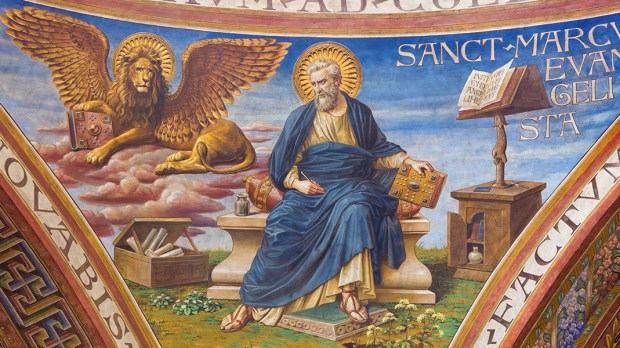If you are going to read the Bible for the first time, start with the Gospel of St. Mark. It is the shortest of the four gospels and it runs breathlessly lickety-split. It, like its subject Jesus, is in a rush to get the Good News out as fast as possible.
Mark’s favorite word is “immediately.” Healings are “immediate.” Jesus ends up some place “immediately” or he leaves for some place else “immediately.” Jesus and his disciples are surging hurriedly forward, as if he knows he has only a limited time.
One place where Mark slows down is in the high priest’s courtyard where Peter disowns Jesus three times. It is a poignant, riveting scene. Peter’s denials of ever knowing the man become more adamant as he is questioned until “He began to call down curses on himself, and he swore to them, ‘I don’t know this man you’re talking about.’”
That one scene, by the way, introduces my next suggestion. Read Mark twice, using two different English versions. Do that to see how one compares to the other. It will raise questions for you, good ones; it will make you think. You may get hooked on it, like I have, reading several of the versions side-by-side to see how they compare to each other. Bible Gatewayis a good place for that, with 150 versions available.
That small quotation (Mark 14:71) cited above is from the New International Version. Contrast that same verse with another: “He began to curse and to swear, ‘I do not know this man about whom you are talking.” That is from the New American Bible Revised Edition.
What’s missing? I cannot find Peter “calling down curses on himself” in any other translation on my shelves. Nor does the original Koine Greek even hint at the construction.
This is why you should read Mark with a second translation in hand, preferably a study Bible with lots and lots of notes. You will see where different translations for different reasons depart from another.

Read more:
Just 2 min a day with the Gospels, and your life will change, says Francis
Whatever the translation you are reading the translator (usually a committee of scholars) is trying to make sense of a first-century writer, whose own grasp of Koine Greek grammar is occasionally iffy. Mark has no hesitation, for instance, in switching tenses mid-sentence. Getting inside Mark’s head (or that of any other first-century Greek writer) and figuring out what he intended to say, and why he said it in the way he did, is challenging.
First-century Greek did not bother with periods at the end of sentences or paragraph indentations, and sometimes words are cut in the middle and picked up at the next line. It means almost every translation is a reverent best guess in punctuation and grammatical structure.
Another thing about Mark: This is about as close as you will come to the actual voice of Peter. Justin the Martyr (d. 165) said early Church worship featured readings of “the memoirs of the apostles.” That, I think, is the distinguishing characteristic of Mark. It is less Mark and more Peter’s memoir.
Early descriptions present Mark as Peter’s interpreter, as if he were recording an oral history and giving it a narrative architecture. That means Mark is recollecting Peter’s recollections, jumbled as those might be. Mark is not necessarily accurate about location or chronology. Yet far from making Mark in any sense inaccurate, it lends strength to early Church opinion that Mark’s gospel consists in Peter’s oral recollections.
Mark, who likely never knew Jesus, recorded Peter, and did record Jesus as accurately as possible through Peter. For the record, I accept an early date for Mark, AD 55-65, when Peter was living and had time to talk.
Even if Mark had to invent the narrative connections between this event in this place and another in a different place, and between what Jesus said one time and what he said on another, Mark paid attention to what Peter said Jesus did and said.

Read more:
Saint Mark: Father of Coptic Christianity
Next thing to do is find a good commentary. As it happens, I have one written by a friend. Dr. Leroy Huizenga is a New Testament scholar, professor, and author, currently at the University of Mary in Bismarck, North Dakota. He also goes ice fishing in -20 degree weather, but I’ll just let that sit here. My opinion, for which he has not paid me anything, is his commentary on the “underdog gospel” of St. Mark is probably the freshest available. You will be happy to read it.
Last, maybe the most instructive, look for people in Mark who are identified by name. Not the high priest or the Roman governor, but people way, way off the social power grid. They show up frequently. It seems to be a concern of Mark, through Peter, that you know these people and their names.
I am minded specifically of blind Bartimaeus of Jericho (10:46-52). “Master,” he says after making a pest of himself, “I want to see.” Snap, goes Jesus. “Immediately,” there’s that word again, “(Bartimaeus) received his sight …”
Why remember this nobody, a beggar in Jericho? Because he got up and “followed [Jesus] on the way.”
“The Way” ought to be capitalized. That’s how friends of Jesus thought of themselves, as people on The Way. See that in any of the Gospels, you know the path of travel.
Christians remembered Bartimaeus’ story, one he himself probably told time and again. They knew Bartimaeus as one of their own. He was their Bartimaeus traveling the same Way. Once blind but now with eyes unhindered, Bartimaeus himself followed Jesus, in the Gospel of Mark.

Read more:
Which of the four Gospels are you?

